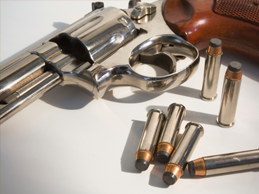New York Court of Appeals
2015 NY Slip Op 04165
Decided May 14, 2015
Although The Defendant Never Gained Access To The Restaurant, He Was Found Guilty Of Robbery Because He Was Present And Possessed The Requisite Mental Intent To Commit The Crime.
Issue: Whether the evidence was sufficient to show an attempted robbery where the defendant was apparently armed and masked with the intent to commit a robbery, but never gained access to the place of business he intended to rob.
Holding: the Court of Appeals found that the evidence was sufficient for a conviction of attempted robbery because the element of intent to rob was present where the defendant and his accomplice had BB guns, their faces covered with masks and, in the early morning hours, went to a Wendy’s restaurant, which was closed at the time, and banged loudly on the back door. The police were called before the two ever entered the restaurant and, after a brief chase, they were arrested.
Author’s Note:
The Court of Appeals focused its analysis on the mens rea element of intent to commit the crime. What the Court left out was the analysis of the actus reus of the crime and whether or not there were sufficient facts here to make out that portion of an attempted robbery. Although it is clear that the defendants here “intended” to rob the Wendy’s (making out the mens rea element of the crime), it is unclear that the actus reus was committed by the defendants because they never entered the restaurant; they never encountered anyone to threaten them with the BB guns (or what appeared to be a real gun); and there was never any immediate use of physical force to steal property because they had no access to the restaurant. This case provides an interesting analysis of what acts are necessary (how far does one have to go) to “attempt” to commit a crime. Is the act of being present with the requisite mental intent sufficient to make out an attempt to rob or burglarize. Apparently, the Court of Appeals feels that it is.
 Summary of facts: According to the undisputed evidence at defendant’s nonjury trial, at approximately 6:30 am, before the morning business hours, defendant and an accomplice appeared armed and masked at the rear door of a Wendy’s fast-food establishment. The two lone employees who were preparing to open heard loud knocking, and one of them checked the security camera and saw defendant and his accomplice outside the back, knocking on the door. The employee did not let the two men in, but instead called his supervisor and 911.
Summary of facts: According to the undisputed evidence at defendant’s nonjury trial, at approximately 6:30 am, before the morning business hours, defendant and an accomplice appeared armed and masked at the rear door of a Wendy’s fast-food establishment. The two lone employees who were preparing to open heard loud knocking, and one of them checked the security camera and saw defendant and his accomplice outside the back, knocking on the door. The employee did not let the two men in, but instead called his supervisor and 911.
A police officer responded in a marked patrol car, and as he pulled up with his car lights shining on the back of the Wendy’s he saw two men hiding behind some stacked up crates. Upon seeing the car lights, defendant and his accomplice ran in different directions, with defendant running towards the officer.
The officer saw defendant dressed in dark blue clothing, wearing a black knit hat, black gloves and a black mask over his face, and observed defendant carrying what appeared to be a black handgun. When the officer drew his weapon, defendant ran towards the nearby highway. The officer followed in his car and later tracked defendant on foot, at which point a K-9 officer responded to the first officer’s call for assistance. During the chase, the officers recovered a black knit hat and a black glove. When the officers eventually caught up with defendant they found him hiding between two buildings, and in possession of a backpack which contained a pair of green, black and yellow gloves.
A subsequent search in the vicinity of the Wendy’s led police to discover two BB guns. The police found one about 10 feet from the establishment’s rear door, near where the first officer initially spotted defendant. The police recovered the other from defendant’s car, which the police found parked in a lot about 50 feet away from the Wendy’s.
 The People charged defendant with two counts of attempted robbery in the second degree (Penal Law 110.00, 160.10 [1] and Penal Law 110.00, 160.10 [2] [b]) and one count of attempted burglary in the second degree (Penal Law 110.00, 140.25 [1] [d]). At trial, defendant stipulated to the introduction into evidence of footage from the security camera, which showed the two masked men looking in and knocking on the Wendy’s rear door, while holding what appeared to be guns. He further stipulated that he was one of the masked men and that he was the person who ran towards the officer and who was later apprehended by the police.
The People charged defendant with two counts of attempted robbery in the second degree (Penal Law 110.00, 160.10 [1] and Penal Law 110.00, 160.10 [2] [b]) and one count of attempted burglary in the second degree (Penal Law 110.00, 140.25 [1] [d]). At trial, defendant stipulated to the introduction into evidence of footage from the security camera, which showed the two masked men looking in and knocking on the Wendy’s rear door, while holding what appeared to be guns. He further stipulated that he was one of the masked men and that he was the person who ran towards the officer and who was later apprehended by the police.
Legal Analysis:The law is well-established that “[a] verdict is legally sufficient if there is any valid line of reasoning and permissible inferences that could lead a rational person to conclude that every element of the charged crime has been proven beyond a reasonable doubt.
The Court did find that a person is guilty of an attempt to commit a crime when, with the intent to commit a crime, the person engages in conduct which tends to effect the commission of such crime” (Penal Law 110.00). An attempt is an act done with an intent to commit some other crime” (People v Bracey, 41 NY2d 296, 299 [1977], citing People v Moran, 123 NY 254, 257 [1890]). Here, the attempted crime is second degree robbery, which is established when a person “forcibly steals property” and “is aided by another person actually present” or “displays what appears to be a … firearm” (Penal Law 160.10 [1], [2] [b]). A person “forcibly steals” when the person “uses or threatens the immediate use of physical force upon another person for the purpose of . . . compelling the owner of such property or another person to deliver up the property” (Penal Law 160.00 [2]). The requisite mental state for robbery is the “intent to permanently deprive the owner of the property.
The Court cited the following facts as evidence of the defendant’s intent: they concluded that there is sufficient circumstantial evidence based on defendant’s appearance and conduct, and the surrounding events to support an inference that defendant intended to commit second degree robbery. With respect to his appearance, defendant and his accomplice were dressed and equipped for criminal acts involving force and threatening behavior in furtherance of a robbery. They wore masks and gloves to enhance their criminal persona and avoid identification by facial recognition or fingerprint verification, and they carried what appeared to be handguns. In addition, defendant was apprehended carrying a backpack, which provided a convenient means to carry stolen property and which contained some additional gloves.
Here, the Court of Appeals found that the actions of the defendant and his accomplice, and the circumstances of the incident do not comport easily with a crime other than robbery. Therefore, they held that the trier of fact was entitled to conclude that it was not a reasonable possibility under the circumstances to find that defendant intended some criminal act other than robbery.

